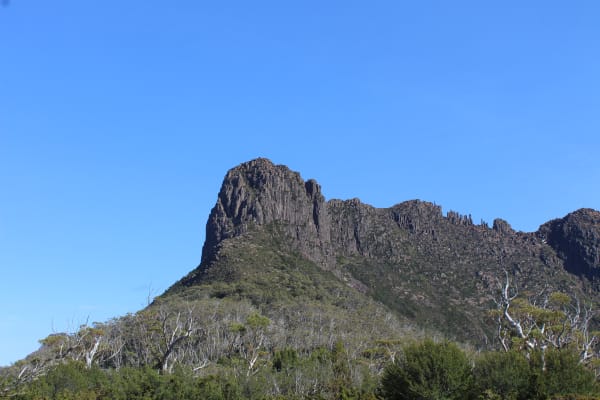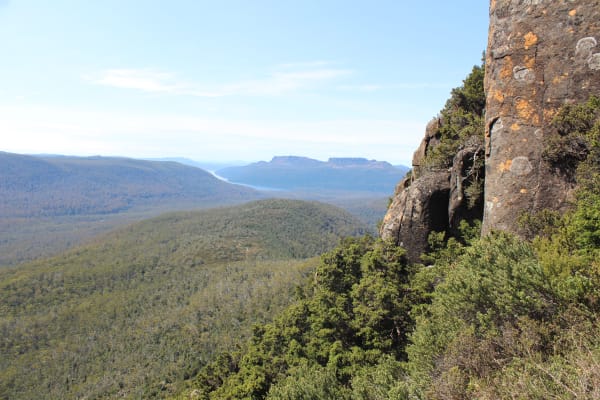Many who embark on the well-known, week-long trek from Dove Lake to Lake St Clair are too spent, eager for a coffee or simply suffering peak-overload to be bothered with the Acropolis.
Cradle Mountain is by now a fond memory. But they have likely already scaled the dolerite nipple of Pelion East, or scrambled up to the 1,617m peak of Mount Ossa. They might have crested a snow-covered Barn Bluff, and maybe Pelion West too.
Those who push on towards Narcissus Hut, however, ignoring the crossroads to Pine Valley, are missing an understated and under-rated classic.
The track in is mostly level forest walking, through a closed-canopy intimate world of King Billy pines, myrtle beech, man-ferns and moss. It’s interwoven with clear, stone-bed brooks, complete with a single-file cable footbridge (at first glance, a bit Indiana Jones, but actually made of sturdy steel).
Nestled in this enchanted vale is Pine Valley Hut, the launching pad for the Acropolis ascent. On the cabin’s verandah the pure-musty fragrance of rainforest mingles with camp cooker metho and the questionable allure of freeze-dried meals. The twilight is spent poring over the map, identifying the peaks that rim the valley as they gradually devour the sun, and silhouette into the silence of a smoky crimson dusk.

When we turn in, the hut is full of snoring, farting adventurers, and every clearing has a tent. It’s peak season.
The mornings start early on the trail, with the hiss of gas stoves and rustle of equipment, as preparations are made for the day’s ascent. People talk in whispers so not to wake those pretending to sleep.
By dawn we are walking again. Not far from camp is the picturesque Cephissus falls, where a huddle of young underwear models brave the frigid waters, toes curled and elbows hugged.
The rainforest track raises steeply past giant eucalypts and ancient Gondwanan pandani plants that look like they’re straight from Fred Flintstone’s front yard.
Before long we climb out of the shade of the rainforest into a button-grass plain, with the Acropolis looming over us like a giant stone fortress. The sky is a blue dome. We’re in luck – the views will be spectacular.
Well-maintained duckboards stretch out towards the fastness, making the plain an easy crossing year-round where once the wrong weather brought boggy sink-holes that stole the boots of seasoned trekkers. But in this sun the mud between the button-grass is dry, pocked with the burrows of Anaspides spinolae, the curious mountain shrimp that lives only in these highlands, hibernating in the dry only to re-emerge when the plane becomes sodden, for a spot of filter-feeding.

. . .
The base of the Acropolis is skirted with a hem of deciduous beech, the seasonally climactic fagus – old tanglefoot. It lives up to its nickname as we negotiate the ankle-rolling roots that nourish its crinkle-cut leaf canopy. I find myself reflecting on how vibrant this landscape is in late autumn as the fagus’s crinkle cut leaves cycle through rusty red to brilliant gold, with the Acropolis moody and fog-crowned above.
We clear the tanglefoot unmolested and start the climb proper, winding up through waratah and the claws of some type of alpine heath.
The sun is bright now and the side of the mountain is devoid of shade. The cool rainforest of the morning is a memory and, foolishly, we have managed to run out of water. As we reach cairn territory, we are parched. There’s still plenty to go before we even reach the summit, let alone the descent back to the cool rivers of the valley.
Scrambling over a spill of boulders, so fresh that their origin high above is still a raw white wound, we pause to appreciate the changed landscape and the natural energy that must have been released so recently.
“Wow, that would have made a noise,” says one experienced walker.
Clambering over the spill I reflect on how much easier this would have been in my 20s, but am also reminded of that old middle-age mantra, “The older you get, the better you were.”

We scale boulders and a few short cliff faces, my old SLR camera clanging against the dolerite. A patch of snow near the ridgeline helps sooth my parched mouth before the last shimmy, and camera banging climb to crest the ridge.
It’s a false-summit with a boulder strewn shoulder yet to conquer, but the view is spectacular – an eagle’s-eye vista of the neighbouring plateau of the Labyrinth below to the south, a patchwork of barren grey and tarns heliographing in the sun. Beyond the Labyrinth, the stony-faced Minotaur stands sentinel. To the east, a valley-framed slice of Lake St Clair, vertigo-inducingly far below. It feels as though you could reach it with a paper plane.
But the spectacle is small beer compared to what’s in store as we scramble up that last stone shoulder to the summit. At the apex, the ultimate panorama is revealed. A hazy 360 degrees of wilderness to the horizon, a panoply of peaks rising from the green folds of Tasmania’s hinterlands. The Du Cane Range marches off to the north, each crown with its own character, culminating in mighty Ossa. Far beyond, the faint edge of a great plateau that much argument amongst the group fails to produce the name of.
Mount Geryon, named after the three-headed monster of Greek mythology, is awesome in his proximity. His east face looms as a dark-buttressed wall to our west, a brooding, dank cathedral from a Tolkien illustrator’s dream. Far to the south is the craggy precipice of Frenchman’s Cap, dominating the simpler brows of the West Coast Range with her distinctive bonce.
. . .

As we collapse on the most comfortable looking boulders we can find, there’s a plethora of insects whirring about us. And skinks, large ones – not surprising given the insects available to them.
Someone produces an orange from his pack, a beautifully succulent orange, and divvies the fruit into slivers of thirst-quenching glory. I will never look at an orange the same way again. The childhood joy of half-time soccer oranges pales to that satiating burst of liquid in that most awesome of platforms, as Tasmania’s wilderness crowed its brilliance all around us.
We lingered up there, and lingered some more, drinking in the view, before we began the thirsty work of the descent.
As is the way of these things, the downhill was slow and knee-jarring. We were happy to reach the petrichor shade of the rainforest, and on the Elysian Fields upon making the first stream. We sat for some time sprawled on its banks glugging the frigid mountain water, glad to be rehydrated at last.
But nothing beats that orange on the peak.
Jonno Blood has been chased by angry gypsies in Hungary, arrested by soldiers in the Ukraine, and slept in a three-metre wide bed with a Red Yao chieftain and his five wives in China. He has also lived in London and Melbourne, before easing back into life in his native Tasmania. While still scratching itchy feet often, he loves his island digs, its often hidden stories, and the characters and capers that make it lavishly singular.







